SUMMARY
This is AI generated summarization, which may have errors. For context, always refer to the full article.
![[ANALYSIS] There is nothing to gain from ignoring bad numbers](https://www.rappler.com/tachyon/2021/05/TL-Ignoring-bad-numbers-May-1-2021.jpg)
In a recent article, Rappler business reporter Ralf Rivas showed how the Duterte economic team glossed over bad numbers in a pre-SONA forum. What does turning a blind eye gain for these managers? Fewer harsh comments from the public, perhaps? But will the bad numbers simply go away? They will not.
Here are three sets of bad numbers that this government is turning a blind eye to. And these are in addition to the worst numbers of all (not included here), which is the pandemic.
Per capita Gross Domestic Product*
* (in 2018 pesos, at constant prices, sourced from the Philippine Statistical Authority)
The chart below shows the ugliness of the bad.
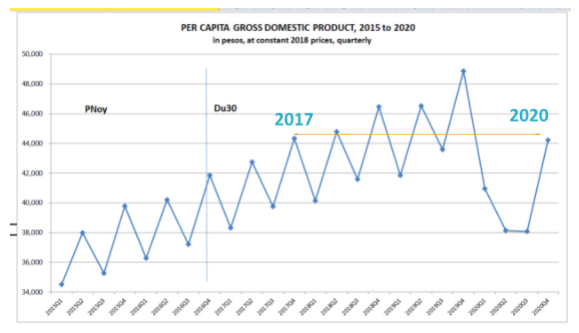
Until the pandemic, the per capita GDP seemed to be going on a steady upward trend. But in the first quarter of 2020, this fell from P48,859 to P40,969. By the fourth quarter of 2020 it recovered somewhat to P44,214 — just about the same level as the fourth quarter of 2017. So whatever gains made in the early years of the Duterte administration seem to have been wiped out by its response to the pandemic. We are back to square one, so to speak.
Why is a fall in per capita GDP significant? Economists have this measure called growth elasticity of poverty or GEP. It measures the percentage reduction in poverty rates for every 1% increase in the per capita GDP. There are various estimates of GEP in the Philippines. Balisacan and Fuwa (2004) arrived at a figure of 1.6 (a 1% increase in GDP per capita will result to a 1.6% reduction in poverty rates). The figure estimated by Reyes and Tabuga (2011) ranges from 1.4 to 1.8. Albert and Vizmanos (2020) have the following estimates for different time periods:
2006 to 2009 – 0.15
2009 to 2012 – 0.32
2012 to 2015 – 0.99
Now, what happens when the per capita GDP falls? This measure is symmetric, which means that when there is a 1% decline in per capita GDP, poverty will increase. Using the GEP estimate of Albert and Vizmanos for the 2012 to 2015 period of -0.99, this means that a 1% decrease in per capita GDP will result in INCREASED poverty rates by 0.99%. (If we used the estimates of Balisacan et. al, the resulting increase in poverty would be higher.)
By how much did per capita GDP fall in 2020? Between 2019 and 2020, the real per capita GDP fell by 10.7%. This means that we should expect the poverty rate to increase by 10.6%! This is BAD. As in, HORRIFICALLY BAD. This government should look at this bad number squarely in the eye and do something about it. It will not simply go away. When poverty worsens, it is harder to overcome it. More effort is required. This problem cannot, must not, be ignored.
The 2020 study of Albert and Vizmanos looks at the vulnerability of households to income poverty. The authors looked at official surveys of family incomes and expenditures from 2003 to 2015. The findings of the authors are relevant to the current situation of the economy under Duterte’s pandemic. They conclude as follows:
“In 2015, about one-seventh (13.9%) of households throughout the country were highly vulnerable and about a third (34.9%) were relatively vulnerable. Thus, as of 2015, about half (48.5%) of Filipino households are vulnerable to income poverty, a third of which are highly vulnerable.”
This is a warning that even those who are not counted among the poor could fall into poverty. Last year’s pandemic response and the continuing restrictions are making more people, who were not necessarily poor to begin with at the time of the lockdown period, more likely to fall into poverty.
Joblessness
Let’s look at another set of figures this government prefers not to see. First of all: net employment. This measure looks at the annual change in the number of employed workers. Below are the figures from 2016 to 2020. (Negative figure means employment fell year on year.) Under this government, net employment was positive in 2018 and 2019. But the employment gains were wiped out by the pandemic (and the government’s response to it) in 2020. Net employment from 2016 to 2020 was a NEGATIVE 1.6 million.

Let’s look at the next measure: unemployment.

So trend-wise, in percentage and in absolute numbers, unemployment is on the rise.
Youth unemployment went from 14.1% in January 2019 to a whopping 31.6% in April 2020. It registered at 19.8% in January 2021 — lower than the lockdown level of April 2020 but still higher than in 2019. In terms of absolute numbers, youth unemployment went from 999,000 in January 2019, to 2 million in April 2020, to 1.4 million in January 2021.
Unfortunately, the bad news doesn’t end here. There’s more. Look at the quality of employment, which has seen a rise in the percentage of the employed who are working part-time.

Also among the employed, the number of underemployed persons (men and women with jobs but who are looking for additional work) is going up.

And here’s bad pa more. The number of Filipino women and men who are not in the labor force (but are of the age group that should qualify them to work) is also going up. For some reason they have opted out of the labor force. They don’t count among the unemployed and the underemployed because they’re not in the labor force. But they are tremendous human potential gone to waste and earning little if at all.

The International Labor Organization has calculated the job losses in the Philippines due to COVID-19. Its key findings are:
- One-fourth of the labor market, equivalent to 10.9 million workers, is likely to face job disruption because of the pandemic. Of this number, 38% are women. The high-risk sectors that will be significantly affected are those industries that cannot operate under containment, and/or that have suffered a slump in demand due to the pandemic. These sectors include manufacturing, transportation, accommodation, food service, entertainment, recreation, and arts.
- “About two-thirds of the 10.9 million workers at risk of COVID-19-induced job disruption are in collapsing or machine terrain occupations (that is, facing high risk of destructive digitalization). This equates to more than 7.2 million workers that are exposed to a double-tiered risk of job disruption.” While digitalization may be seen as a way to uphold health and safety measures, there are jobs that stand the risk of disappearing as a result of digitalization.
- The harmful labor market impact of the pandemic is more pronounced among vulnerable and part-time workers, young people, overseas Filipino workers, women, and healthcare and medical workers. The ILO estimates a third of the country’s workforce are vulnerable workers, whom the ILO describes as “contributing family workers and own-account workers, [who] tend to be paid less, enjoy little labor protection and are likely to be exposed to occupational hazards.”
Inflation
Food prices have been soaring and have been hurting the poor hardest. The triple typhoon that hit Luzon towards the end of 2020 caused damage to crops and roads, limiting supply and hampering the delivery of food to tables around the country. The African swine fever has decimated the hog sector, which will need at least two years (and no swine flu) to get back to “normal.” The diminished supply of pork has also put pressure on the poultry sector. All this is occurring at a time when farmers are suffering the lowest farmgate prices for palay, coconuts, and vegetables. Yet, consumers are not spared from the high food prices. In effect, on both sides of demand and supply, the people are hurting.
Here are monthly inflation rates for the poorest 30% of households, in Metro Manila and areas outside Metro Manila.

The fourth set of bad numbers is the pandemic. Ignoring it isn’t plain ignorance. It’s criminal neglect. Citizens are doing their part with community pantries. This government must face the consequences of its inaction and do something soon. Simply put, this situation is not sustainable. Even the IMF sees little achievements as a result of all the months of lockdown, PH-style. To quote:
“The effectiveness of lockdowns in reducing infection rates also varied across countries. Challenges (caused by government capacity constraints) in implementing and enforcing lockdowns, especially in more densely populated emerging markets with greater levels of informality and poverty (Deb and others 2020a; 2020b) may have made lockdowns less effective (India, Indonesia, Philippines). Limited health care capacity, including in testing and tracing, may have also affected the effectiveness of lockdowns. Several countries ramped up testing and tracing capabilities, but some countries lagged behind (Indonesia, Philippines).”
Several months ago we did an exercise on a post-pandemic budget deficit for 2020. The assumptions used turned out to be highly optimistic: from zero real growth to negative 2% real growth in GDP. The actual figure for 2020 was a negative real growth of 9.5%! What did this do to the budget deficit? Government’s pre-pandemic target was a deficit of 3.2% of nominal GDP. What it got in 2020 was a deficit of 7.6% of nominal GDP. As expected, tax revenues fell by 11.4% from the 2019 level. Because of this, government spending was tightly held back — at a time when the private sector and households had little to fall back on. The spending of 2020 was only P64 billion more than the pre-pandemic program.
Is this amount sufficient to contain the pandemic and support the people at a time of unprecedented crisis? Obviously not.
The ESCAP wrote in November 2020 that the Philippine government raised its budget deficit target for 2020 to 9.6% of nominal GDP. But the actual deficit was lower: 7.6% of GDP. Had the government fulfilled its higher deficit target, it would have had P354 billion more to spend than it actually did. In the same publication, the ESCAP said that “strong fiscal response is essential for facilitating recovery,” based on “extensive empirical evidence from past episodes of adverse shocks.” In a later publication the ESCAP presented a “Risk-Scape” of member-countries, looking at vulnerabilities to a wide range of economic, financial, health, and environmental shocks. Guess where the Philippines ranks in this “Risk-Scape.” See chart below.
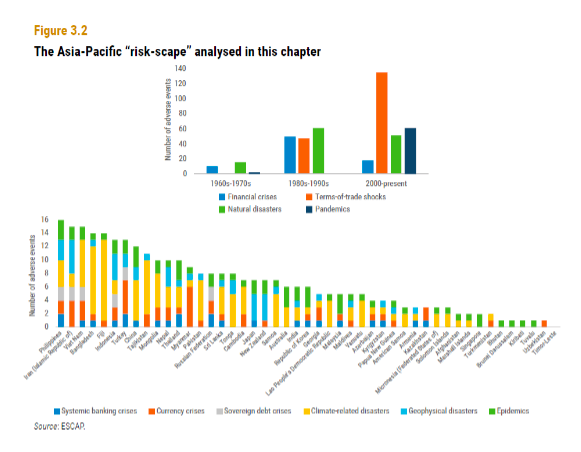
Economist Jesus Felipe of the Asian Development Bank looked at the spending of ADB members during the pandemic, looking at both monetary and fiscal measures. Among ASEAN members, the Philippines had the fourth lowest per capita spending ($188) — ahead only of Cambodia, Laos, and Myanmar, and just after Indonesia. Felipe then looked at what should have been the level of spending in response to COVID-19 deaths and the vulnerability of the population. The level for the Philippines should have been $323 per capita. A similar exercise based on COVID-19 deaths and the proportion to employment of wage and salaried worker, would yield a targeted spending of $825 per capita instead of the $188 per capita spent by the Duterte government. The ADB writes: “The package of the Philippines, on the other hand, is small in absolute value ($188) and several of the models indicate that the package ought to be larger. A package of about $300 per capita would imply a total package 59.0% larger, about $32 billion as opposed to $20 billion.”
Government needed to spend because it was in the best position to do so. And it needed to protect ordinary Filipinos from both the pandemic and the deleterious effects of the lockdown. It needed a strong response to COVID-19, to protect the medical frontliners, arm them with the necessary equipment and support, conduct widespread testing, and enable capacity to trace and track spreaders and super spreaders. It needed to secure the supply of vaccines needed to protect all Filipinos, not just those with money to buy their own vaccines. It needed to ensure that the economy was running in a manner that could provide the basic essentials needed in every home. It needed to protect the most vulnerable of society. It needed to work closely with all government units at all levels to reinforce the health sector and provide social protection for the needy.
Instead, what we see are government actions of passing the burden of home schooling — and now, home care for COVID-19 patients — to women and other family members. This is another form of neglect. Criminal. Politics and corruption aside, citizens’ and sectoral groups have proposed ways forward out of this mess. But it seems this government is set on walking its intransigent, insensitive path to hell. – Rappler.com
Maitet Diokno graduated from the UP School of Economics for her first degree and the London School of Economics for her masters in economics. She is a social entrepreneur who occasionally writes on the economy and on energy democracy.
Add a comment
How does this make you feel?
![[ANALYSIS] Debunking the deadly lies of Duterte’s economic managers](https://www.rappler.com/tachyon/2021/04/tl-debunking-lies-sq.jpg?fit=449%2C449)
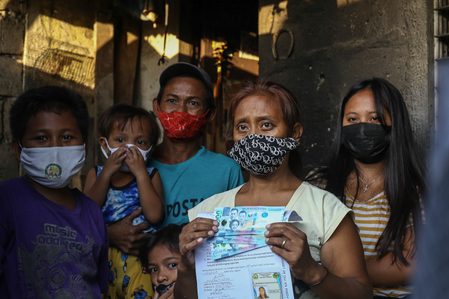
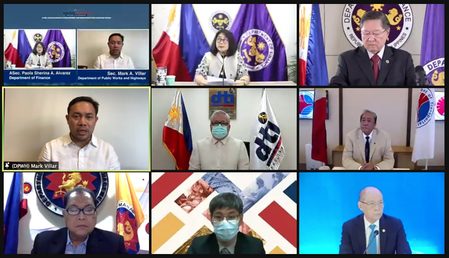


![[Time Trowel] Evolution and the sneakiness of COVID](https://www.rappler.com/tachyon/2024/02/tl-evolution-covid.jpg?resize=257%2C257&crop=455px%2C0px%2C1080px%2C1080px)



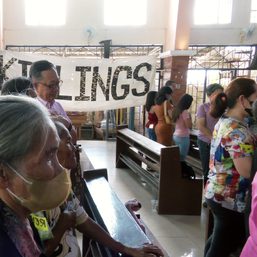

![[Just Saying] Diminished impact of SC Trillanes decision and Trillanes’ remedy](https://www.rappler.com/tachyon/2024/04/Diminished-impact-of-SC-Trillanes-decision-and-remedy.jpg?resize=257%2C257&crop=273px%2C0px%2C720px%2C720px)
![[Rappler Investigates] Son of a gun!](https://www.rappler.com/tachyon/2024/03/newsletter-duterte-quiboloy.jpg?resize=257%2C257&crop=450px%2C0px%2C1080px%2C1080px)
There are no comments yet. Add your comment to start the conversation.